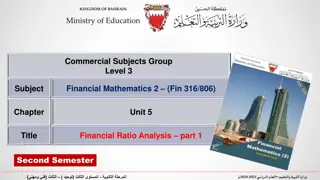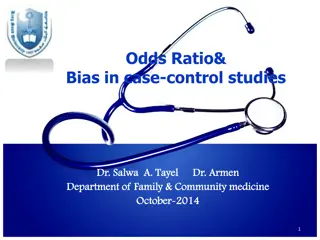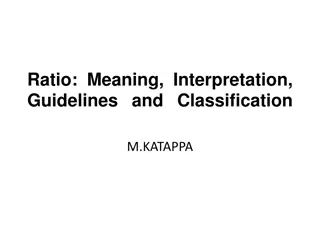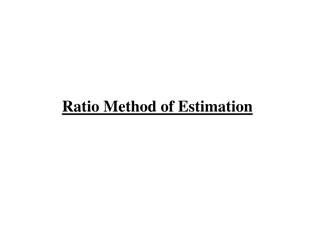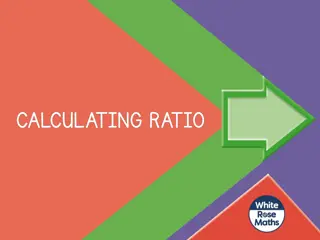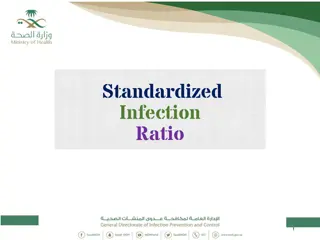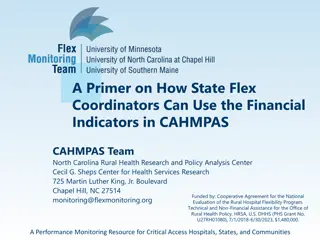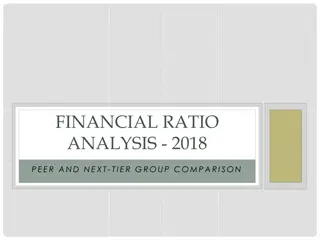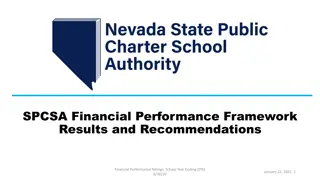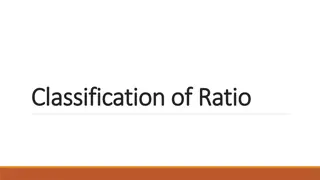A Primer on Financial Ratio Analysis and CAHMPAS
This resource by the CAHMPAS Financial Team at University of North Carolina provides an in-depth look into financial ratio analysis, including the theory, types of analyses, and the importance of understanding financial indicators. It discusses how businesses can assess their financial performance and condition using ratios, aiming to determine the financial capacity to meet their mission. The content highlights the significance of ratio analysis in assessing financial strength and weaknesses.
Download Presentation

Please find below an Image/Link to download the presentation.
The content on the website is provided AS IS for your information and personal use only. It may not be sold, licensed, or shared on other websites without obtaining consent from the author.If you encounter any issues during the download, it is possible that the publisher has removed the file from their server.
You are allowed to download the files provided on this website for personal or commercial use, subject to the condition that they are used lawfully. All files are the property of their respective owners.
The content on the website is provided AS IS for your information and personal use only. It may not be sold, licensed, or shared on other websites without obtaining consent from the author.
E N D
Presentation Transcript
A Primer on Financial Ratio Analysis and CAHMPAS CAHMPAS Team North Carolina Rural Health Research and Policy Analysis Center Cecil G. Sheps Center for Health Services Research 725 Martin Luther King, Jr. Boulevard Chapel Hill, NC 27514 monitoring@flexmonitoring.org March 6, 2020 A Performance Monitoring Resource for Critical Access Hospitals, States, and Communities
CAHMPAS Financial Team University of North Carolina at Chapel Hill Kristin L. Reiter, PhD George H. Pink, PhD G. Mark Holmes, PhD Technical Advisor Roger Thompson, Seim, Johnson, Sestak & Quist LLP 2
Agenda 1. 2. 3. 4. 5. 6. The theory of financial analysis (p4) Overview of the financial indicators in CAHMPAS (p10) Understanding and using the peer groups (p15) Understanding and using the indicators (p29) How hospitals can use CAHMPAS: An example (p58) Benchmarks (p76) 3
Purpose One of the most important characteristics of a business is its financial performance and condition Financial analysis assesses a business s financial performance and condition: Does it have the financial capacity to meet its mission? Results sometimes focus on financial strengths and weaknesses 5
Types of Financial Analyses Several types are used: Financial statement analysis focuses on the information in a business s financial statements with the goal of assessing financial condition Operating indicator analysis focuses on operating data with the goal of explaining financial performance CAHMPAS includes financial statement and operating indicator analyses 6
Ratio Analysis Ratio analysis is a technique used in both financial statement and operating indicator analyses It combines values from the financial statements (and elsewhere) to create single numbers that: have easily interpretable financial significance facilitate comparisons 7
Interpreting Ratios A single ratio value has little meaning: One point in time that may not be representative Can t tell if it is better or worse than other hospitals Therefore, two techniques are commonly used to help interpret the numbers : Trend (time series) analysis Comparative (cross-sectional) analysis Both techniques are used in CAHMPAS 8
Using Ratios Ratios help to identify: Questions to ask Issues to address Problems to solve Ratios do not necessarily provide Answers Explanations Solutions 9
2. Overview of the Financial Indicators in CAHMPAS 10
Objectives of the Financial Indicators in CAHMPAS To select and construct a set of financial performance measures that are relevant to Critical Access Hospitals (CAHs) To provide comparative information that CAH boards and administrators can use to improve financial performance To improve the quality of Medicare Cost Report data reported by CAHs (our goal) 11
Financial Ratios in CAHMPAS Profitability indicators measure the ability to generate the financial return required to replace assets, meet increases in service demands, and compensate investors Total margin, cash flow margin, return on equity, operating margin Liquidity indicators measure the ability to meet cash obligations in a timely manner Current ratio, days cash on hand, days in net accounts receivable, days in gross accounts receivable 12
Financial Ratios in CAHMPAS Capital structure indicators measure the extent of debt and equity financing Equity financing, debt service coverage, long-term debt to capitalization Outpatient indicators measure the amount of revenues and expenses that are from outpatient services Outpatient Revenue to Total Revenue, Hospital Medicare Outpatient Payer Mix, Hospital Medicare Outpatient Cost to Charge 13
Financial Ratios in CAHMPAS Inpatient indicators measure the amount of revenues, expenses, and utilization that are from inpatient services Medicare Inpatient Payer Mix, Medicare Inpatient Cost per Day, Acute Average Daily Census, Swing Average Daily Census Growth indicators measure the amount of growth in operating revenue and expenses for 1 and 3 years 1-Year Change in Operating Revenue, 3-Year Change in Operating Revenue, 1-Year Change in Operating Expense, 3-Year Change in Operating Expense 14
Financial Ratios in CAHMPAS Labor indicators measure workforce metrics FTE per Adjusted Occupied Bed, Average Salary per FTE, Salary to Net Patient Revenue Other indicators measure additional metrics not classified by the other domains Average Age of Plant, Patient Deductions, Medicaid Payer Mix, Uncompensated Care, Reinvestment
First Issue of the CAH Financial Indicators Report In Summer 2004, hospital-specific reports were sent to 853 administrators An evaluation form was included Many respondents requested comparison of their performance to similar CAHs 17
Selection of CAH Peer Groups Suggestions from respondents Literature review to identify important peer groups in other studies Advice of Technical Advisory Group Potential peer groups evaluated using statistical analysis Selected peer groups: Important influences on indicator values Could be validly defined from Cost Reports 18
Creation of CAH Peer Groups From Medicare Cost Report data, we identified factors important to CAH financial performance: Had <$10 million, $10-20 million, or >$20 million in net patient revenue Provided long-term care Was owned by a government entity Operated a Rural Health Clinic 19
# of Indicators that Varied for Each Factor Financial performance and condition varied significantly among the peer groups: # of Indicators Net patient revenue 16 / 20 Provided long-term care 10 / 20 Owned by government 10 / 20 Operated a Rural Health Clinic 7 / 20 20
Creation of CAH Peer Groups All combinations of the four factors were used to create 24 peer groups Every CAH is assigned to one of the 24 peer groups Indicator medians are calculated for each peer group 21
Second Issue of the CAH Financial Indicators Report In Summer 2005, hospital-specific reports were sent to 1,029 administrators Peer group, state, and national medians Summary graph of performance relative to peer group An evaluation form was included and most respondents affirmed the selected peer groups Many wanted peer group comparisons for CAHs in their state 22
Net Patient Revenues Larger CAHs were more profitable and could carry more debt, possibly because: More diagnostic and outpatient services Higher charges, lower costs, or both Lower proportion of Medicare patients Higher patient volume generates higher total revenue and lower fixed costs per patient Other reasons? 23
Net Patient Revenues Larger CAHs also had: Higher Medicare revenue per day (greater patient acuity, ICU/specialty service, higher wages in larger communities?) Lower salaries to total expenses (more equipment, higher drug costs?) Newer average age of plant (greater debt capacity?) 24
Provided Long-Term Care CAHs that provided long-term care were less profitable, possibly because: Higher proportion of Medicaid patients Medicare Cost Report accounting methods Lower patient volume Other reasons? 25
Provided Long-Term Care CAHs that provided long-term care also had: Lower days revenue in accounts receivable (LTC bills submitted prior to service?) Lower outpatient revenue to total revenue (LTC revenue is in the denominator) Higher salaries to total expenses (high touch / low tech nature of long-term care?) 26
Owned by Government CAHs that were owned by the government were less profitable but more liquid, possibly because: Higher charges, lower costs, or both Lower patient volume Other reasons? CAHs that were owned by the government also had: Higher current ratio (lower use of debt) Older average age of plant (lower use of debt?) 27
Operated a RHC CAHs that operated a RHC were less profitable, possibly because: Higher proportion of Medicare inpatients Lower patient volume Other reasons? CAHs that operated a RHC also had: Higher salaries to total expenses (physician compensation in numerator?) 28
Conclusion CAHs are not all the same - significant differences in financial performance and condition exist among CAH peer groups May be misleading or unfair to compare the financial performance of a smaller CAH to a larger CAH, a CAH that does not provide LTC to a CAH that provides LTC, and so on Compare CAH financial performance: First to peer group median Second to state median Third to U.S. median 29
An Example: Our Hospital Let s look at indicator values for Our Hospital For all of the indicators: Our Hospital is best performer Peer group median is second best State median is third best U.S. median is fourth best All of the numbers are contrived except for the U.S median 31
Profitability: Total Margin 2018 2018 Peer Group Median CAH 2018 State Median CAH 2018 U.S. Median CAH Our Hospital 1.61 Net income Total revenue Definition Interpretation Measures the control of expenses relative to revenues Is a higher total margin always good? 32
Profitability: Cash Flow Margin 2018 2018 Peer Group Median CAH 2018 State Median CAH 2018 U.S. Median CAH Our Hospital 5.71 Net income (Contributions, investments, and appropriations + Depreciation expense + Interest expense) Net patient revenue + Other income Contributions, investments, and appropriations Definition Interpretation Measures the ability to generate cash flow from providing patient care services Why might total margin be negative and cash flow margin be positive? 33
Profitability: Return on Equity 2018 2018 Peer Group Median CAH 2018 State Median CAH 2018 U.S. Median CAH Our Hospital 4.24 Definition Net income Net assets Measures the net income generated by equity investment (net assets) Interpretation What is net assets? 34
Profitability: Operating Margin 2018 2018 Peer Group Median CAH 2018 State Median CAH 2018 U.S. Median CAH Our Hospital .17 Net patient revenue + operating income total operating expenses Net patient revenue + other revenue Definition Measures the control of operating expenses relative to operating revenues Interpretation Is a higher operating margin always good? 35
Liquidity: Current Ratio 2018 2018 Peer Group Median CAH 2018 State Median CAH 2018 U.S. Median CAH Our Hospital 2.54 Current assets Current liabilities Definition Measures the number of times short-term obligations can be paid using short-term assets Interpretation Is a higher current ratio always good? 36
Liquidity: Days Cash on Hand 2018 2018 Peer Group Median CAH 2018 State Median CAH 2018 U.S. Median CAH Our Hospital 75.88 Cash + temporary investments + investments (Total expenses Depreciation) / Days in period Definition Measures the number of days an organization could operate if no cash was collected or received Interpretation How would you interpret 5 days cash on hand? 37
Liquidity: Days in Net Accounts Receivable 2018 2018 Peer Group Median CAH 2018 State Median CAH 2018 U.S. Median CAH Our Hospital 50.68 Net patient accounts receivable (Net patient revenue) / Days in period Definition Measures the number of days that it takes an organization to collect its receivables Interpretation Is a higher days revenue in accounts receivable always bad? 38
Liquidity: Days in Gross Accounts Receivable 2018 2018 Peer Group Median CAH 2018 State Median CAH 2018 U.S. Median CAH Our Hospital 49.06 Gross patient accounts receivable (Gross patient revenue) / Days in period Definition Measures revenue cycle performance (when compared to days in net A/R.) Interpretation Is a higher days in gross accounts receivable always bad? 39
Capital Structure: Equity Financing 2018 2018 Peer Group Median CAH 2018 State Median CAH 2018 U.S. Median CAH Our Hospital 59.69 Net assets Total assets Definition Measures the percentage of total assets financed by equity Interpretation Is a higher equity financing always good? 40
Capital Structure: Debt Service Coverage 2018 Our Hospital Group Median CAH 2018 Peer 2018 State Median CAH 2018 U.S. Median CAH 3.43 Net income + Depreciation + Interest expense Notes and loans payable (short term) * (365/DIP)+ Interest expense where DIP means days in period Definition Interpretation Measures the ability to pay obligations related to long- term debt, principal payments and interest expense What happens if a hospital has no debt? 41
Capital Structure: Long-Term Debt to Capitalization 2018 2018 Peer Group Median CAH 2018 State Median CAH 2018 U.S. Median CAH Our Hospital 30.83 Long-term debt Long-term debt + Net assets Definition Interpretation Measures the percentage of total capital that is debt Is a lower long-term debt to capitalization always good? 42
Outpatient: Outpatient Revenues to Total Revenues 2018 2018 Peer Group Median CAH 2018 State Median CAH 2018 U.S. Median CAH Our Hospital 79.40 Total outpatient revenue Total patient revenue Definition Measures the percentage of total revenues that are for outpatient revenues (including, for example, Rural Health Clinics, free-standing clinics, and home health clinics) Interpretation 43
Outpatient: Hospital Medicare Outpatient Payer Mix 2018 2018 Peer Group Median CAH 2018 State Median CAH 2018 U.S. Median CAH Our Hospital 37.13 Hospital Outpatient Medicare charges Hospital Total Outpatient Charges Definition Measures the percentage of total outpatient charges that are for Medicare patients Interpretation 44
Outpatient: Hospital Medicare Outpatient Cost to Charge 2018 2018 Peer Group Median CAH 2018 State Median CAH 2018 U.S. Median CAH Our Hospital 43.51 Hospital Medicare Outpatient Costs Hospital Medicare Outpatient Charges Definition Measures outpatient Medicare costs per dollar of outpatient Medicare charges Interpretation 45
Inpatient: Medicare Inpatient Payer Mix 2018 2018 Peer Group Median CAH 2018 State Median CAH 2018 U.S. Median CAH Our Hospital 71.94 Medicare inpatient days Definition Total inpatient days Nursery bed days NF Swing bed days Measures the percentage of total inpatient days that are provided to Medicare patients Interpretation 46
Inpatient: Medicare Acute Inpatient Cost per Day 2018 2018 Peer Group Median CAH 2018 State Median CAH 2018 U.S. Median CAH Our Hospital 2830 Medicare acute inpatient cost (Medicare Inpatient Days (excl. HMO)) Definition Measures the average daily cost of a Medicare acute inpatient Interpretation 47
Inpatient: Average Daily Census Acute Beds 2018 2018 Peer Group Median CAH 2018 State Median CAH 2018 U.S. Median CAH Our Hospital 2.54 Inpatient acute care bed days Days in period Definition Measures the average number of acute care beds occupied per day Interpretation 48
Inpatient: Average Daily Census Swing-SNF Beds 2018 2018 Peer Group Median CAH 2018 State Median CAH 2018 U.S. Median CAH Our Hospital 1.53 Inpatient swing bed SNF days Days in period Definition Measures the average number of swing-SNF beds occupied per day Interpretation 49
Growth: 1-Year Change in Operating Revenue 2018 2018 Peer Group Median CAH 2018 State Median CAH 2018 U.S. Median CAH Our Hospital 3.9 Operating revenue (year t)- Operating revenue (year t-1) Operating revenue (year t-1) Measures the change in operating revenue over 1 year Definition Interpretation 50






